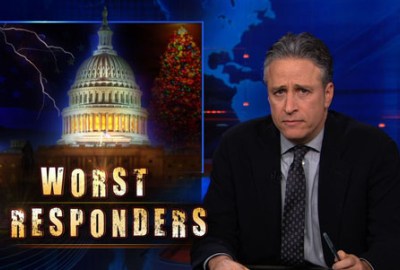How 9/11 First Responders and Jon Stewart Successfully Pressured Congress

–Guest post by Kimberly Short, American University graduate student.
In a 2009 article, Hamilton Bean analyzed the communication strategy of the 9/11 families in their successful pursuit to obtain answers during the 9/11 Commission process. But how did they do it? How did they garner public attention when news sources had typically shied away from the controversies of 9/11? And how might their strategy apply to other cases? Bean, a scholar of public rhetoric at the University Denver, argues that the answer starts with understanding the “parrhesia.”
Parrhesia, as defined by Bean, is “speech uniquely characterized by frankness, truth, criticism, danger and duty” (429). In his article, “’A Complicated and Frustrating Dance:’ National Security Reform, the Limits of Parrhesia, and the Case of the 9/11 Families,” Bean argues that it was this communication technique that helped the 9/11 families gain awareness and a voice in public and government discourse when seeking answers to the reasons behind the terrorist attacks. Bean discusses how frank and explicit depictions of the families’ 9/11 experiences allowed them to enter into discourse with the administration while their position as victims leveraged the strength of their arguments.
The 9/11 Commission emphasized the concerns of the victims’ families, yet Bean contends that the government’s seemingly supportive response was countered by contradictory action of little follow through. Regardless, the initial engagement and communication development was very likely an effect of their strategic use of parrhesia.
Despite Bean arguing that government authority can effectively counter the effects of parrhesia, the question still remains, where else could this rhetorical strategy have been effective? Specifically, could the 9/11 first responders have benefited from a parrhesia-like strategy when lobbying Congress to pass the first responders’ health care bill, also known as the Zadroga Bill? Named after James Zadroga who died in 2006 of causes presumed to be connected to toxic conditions at Ground Zero, the bill was passed in 2010, nine years following the terrorist attacks.
So could first responders have utilized parrhesia to the same extent as the 9/11 families? My answer is yes and they did; but only when the time was right and conditions in their favor.
On one hand, Bean references the French scholar, Foucalt, when he says that parrhesia occurs “only if there is a risk or danger for [a person] in telling the truth” (435). This was indeed the case for 9/11 first responders who were an active component of the government’s response system during 9/11. They risked damaging relationships by criticizing a government that just 10 years ago considered them a partner in the fight against terrorism. The first responders, however, were likely to regard this as a risk worth taking, making parrhesia a potentially effective strategy.
Bean also notes that blunt wording develops your position as a victim and directly correlates with an effective parrhesia strategy. This blunt wording requires moral qualifications which in turn lend the speaker the authority to criticize an institution. Bean writes, “Positive parrhesia … displays courage, moral integrity, and reasonableness, and it is spoken by citizens possessing ‘political competence’” (440). The first responders were already revered as heroes with great courage and moral integrity. As later studies proved that there was a link between Ground Zero and health issues, scientific evidence backed their claims and they could then exhibit the “reasonableness” and “political competence” that Bean necessitates.
Today, we can see components of parrhesia communication strategies at work. Multiple 9/11 tenth anniversary television specials featured fire fighters discussing explicit and detailed accounts of respiratory problems and post traumatic stress disorder. Perhaps, most infamously, in 2010, Jon Stewart featured firefighters on The Daily Show, where they spoke frankly and directly about cancer diagnoses, fallen firefighter brethren, and the Senate filibuster of the Zadroga bill.
However, if we look at moments directly following 9/11, parrhesia may not have been as effective. Early on, there were fewer completed studies to prove the link between health issues and Ground Zero conditions. Couple this with the EPA denying in 2001 that Ground Zero posed hazardous air quality conditions, and you have an uphill battle for first responders leveraging themselves as victims to the public.
If there is no factual evidence behind their health claims, the public may have questioned their credibility as reasonable citizens with moral integrity. Perhaps one of the first responders’ biggest communication barriers when trying to utilize parrhesia was in identifying themselves as victims. Most of us view the firefighters in light of the heroic images broadcast and portrayed following 9/11, as depicted in commemorative stamps, and similar imagery.
To America, they were the heroes of 9/11. Perhaps, it was too difficult to reframe their representation in America as suffering citizens that now require health care support. Maybe the juxtaposition between first responders as both heroes and victims was too complex for the public and the media. In the end, based on Bean’s definition, parrhesia could have been (and probably was) effective for 9/11 first responders; but like many almost everything, the time had to be right for the strategy to work.
–Guest post by Kimberly Short, an MA student in Public Communication at American University in Washington, D.C.
Read other posts from her project team examining the 9/11 responder’s communication campaign as well posts from other project teams in her course on Public Communication Theory.
See also previous posts on Jon Stewart’s political impact.
References:





